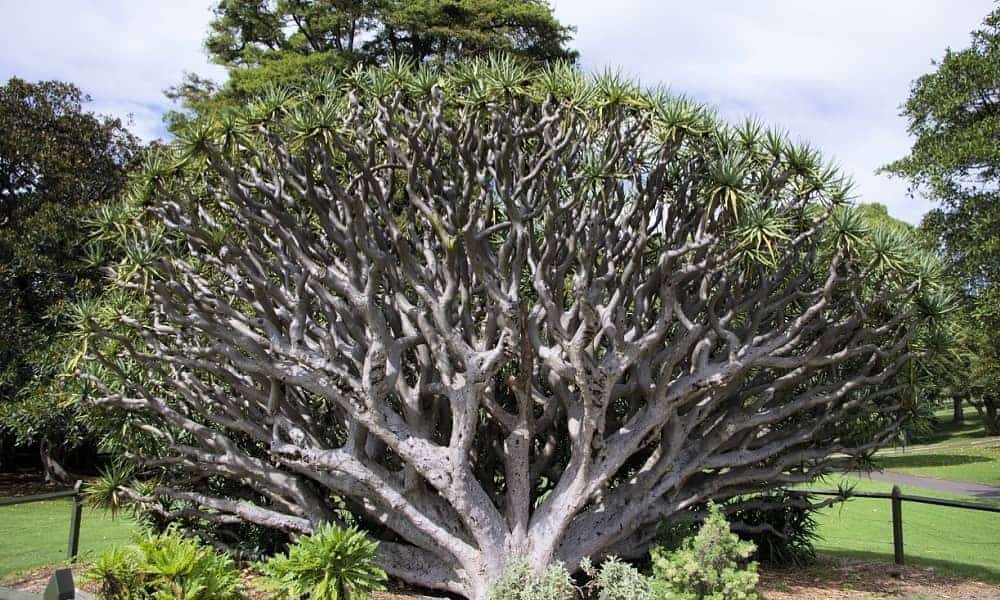You might be drawn to the dragon tree for its dramatic, sculptural appearance, but it’s more than just a beauty — it’s a living piece of history!
The dragon tree is known for its umbrella-shaped canopy and deep red resin called ‘dragon’s blood,’ which has been used and traded for centuries.
With its mythical charm and hardy nature, the dragon tree makes a stunning addition to any Aussie garden or home.
But fair warning: the dragon tree is a slow grower that can live for centuries, so don’t expect to achieve its iconic look overnight.
When to Plant | Growing Conditions | Where to Plant | How to Plant | Care | Propagation | Common Problems
All About the Dragon Tree
The dragon tree (Dracaena draco) is a succulent evergreen tree and a natural symbol of Tenerife, which is part of Spain’s Canary Islands.
Some call it the Canary Islands dragon tree, but it’s also native to Cape Verde, Madeira, and western Morocco.
It’s an extremely long-lived tree. The oldest known dragon tree, ‘El Drago,’ is located in northern Tenerife and is estimated to be between 800 and 1,000 years old.
Why is it called ‘dragon blood tree?’

D. draco is also called ‘dragon blood tree’ because its trunk and branches ooze a red resin called ‘dragon’s blood’ when wounded.
Dragon’s blood has been used for centuries in traditional medicine, as a dye or pigment, and in rituals and spiritual practices.
Legend suggests that this red resin was used as a varnish for Stradivarius violins!
It’s also believed to appear in Giotto’s painting called ‘Pentecost,’ specifically for the orange-red flames over the Apostles’ heads.
What does a dragon tree look like?
The dragon tree looks truly magnificent! The tree’s branching growth pattern (also called an umbrella-like habit) gives D. draco its signature dense, rounded canopy.
It has a thick, gnarled trunk from which multiple layers of branches emerge and divide further.
Each branch is topped with thick, sword-like, greyish-green leaves arranged in a rosette pattern, making the tree look ‘multi-headed.’
Clusters of white blossoms appear on a flower spike above the leaves.
Mature dragon trees can reach 12–15m tall and 5–8m wide, and the trunk can grow to about 5m in circumference.
How long does it take for a dragon blood tree to grow?
A young D. draco starts from a single stem (or trunk) and is incredibly slow-growing. It takes 10–20 years to reach 1m tall and produce its first flowers, usually in late winter to early spring.
After their season, the blooms will give way to small, inedible fruits that are usually orange or red.
When the dragon tree’s fruits are gone, a crown of terminal buds appears where the flowers were and gives way to new branches.
From there, you’ll need to wait another decade or two before the dragon tree starts its next cycle of blooming, fruiting, and branching.
When to Plant a Dragon Tree in Australia

The best time to plant a dragon tree in Australia is in spring or early summer, when the weather is mild and there’s no risk of frost.
You can also plant them in autumn.
Dragon Tree Growing Conditions
Dragon trees are very hardy — they can withstand long dry spells and even rocky soils.
Still, like other plants, they’ll thrive most in their ideal conditions.
Climate
The dragon tree is highly drought-tolerant and thrives in arid, subtropical, and tropical climates. It prefers temperatures between 16°C and 27°C.
It can also handle salty winds and soils, so it’s well-suited even for coastal gardens.
But while the dragon tree adapts to most of Australia, it struggles in the wet tropics and frost-prone regions.
It can only handle temperature drops to 5°C–10°C for short periods — just slightly more cold-hardy than other Dracaena plants.
In areas with heavy rainfall or frost, it’s best to grow the dragon tree in a container. Then you can move it indoors during harsh weather.
Light
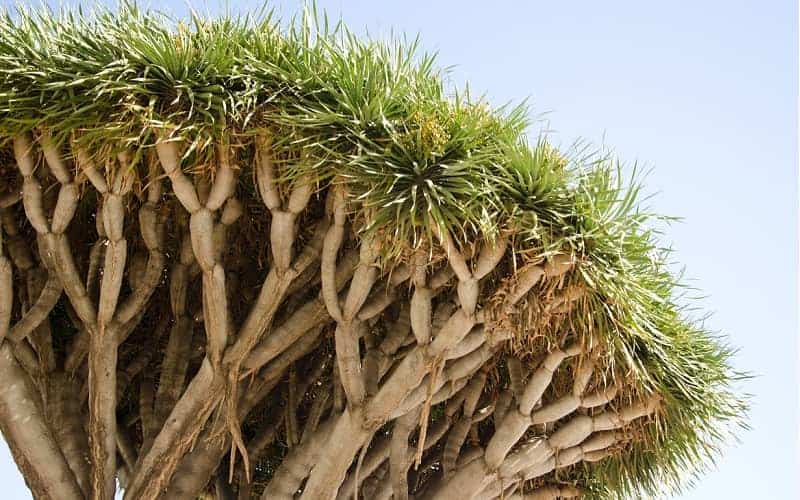
The dragon tree can tolerate varying light levels, but it grows best in full sun to part shade.
Ideally, your tree should get at least 6 hours of direct sunlight per day. A bit of afternoon shade can help protect it from intense light and heat.
When growing a dragon tree indoors, it needs a bright spot away from the harsh afternoon sun. Place it near an east- or northeast-facing window.
Soil
Dragon trees need well-drained soil with a slightly acidic to neutral pH (6.0-7.0).
Look for sandy or gravelly soils, which give plenty of drainage. For potted trees, use a succulent or cactus potting mix.
Opt for a mix with little or no perlite to avoid fluoride exposure, which can harm your tree.
While they’re not too fussy about the specific soil type, dragon trees are very sensitive to poor drainage.
If your soil retains moisture, like loam or clay, amend the soil with sand to improve drainage.
You can also create a raised mound at least 50cm high and 1m wide to prevent the dragon tree’s roots from sitting in water.
Where to Grow a Dragon Tree
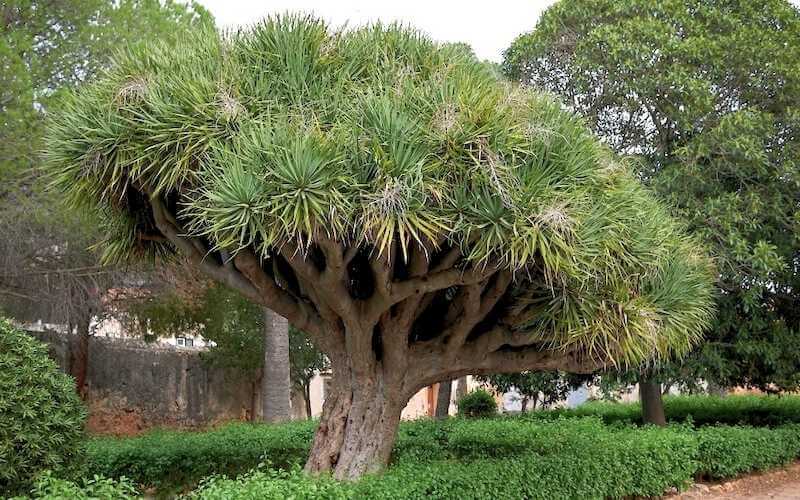
You can grow dragon trees indoors and outdoors — they’re a standout feature plant wherever they’re planted!
Growing a dragon tree indoors
You probably think the dragon tree is too big to grow indoors, but it actually makes an excellent houseplant!
Thanks to its slow growth, the dragon tree is unlikely to outgrow its indoor space anytime soon. Plus, it usually stays much smaller when grown indoors — up to about 1.8m tall.
Just keep in mind that the tree will eventually need a sturdy, large container to support its top-heavy growth. The pot should also be elevated to allow for proper drainage.
Also, consider the tree’s light requirements. Dragon trees can adapt to lower light levels, but they grow best when placed near a bright, sunny window.
Growing a dragon tree outdoors
When planting a dragon tree outdoors, it’s important to choose the right spot.
Remember that it can live for hundreds of years and eventually become massive, even if it happens at a snail’s pace.
Your future self (or your grandkids) won’t want to deal with a poorly placed, fully grown tree!
Also, consider how the dragon tree will fit into your landscape design.
Mature plants with multiple ‘heads’ of leaves can be a centrepiece in your garden. Meanwhile, single-crown dragon trees look great when planted in groups or rows.
If you’re unsure how to design your garden, you can consult landscaping pros to find the best layout for your dragon trees and other plants.
They can also provide lawn care and hedge trimming services to keep your garden looking neat and well-groomed.
How to Plant a Dragon Tree
You can grow a dragon tree from a young plant or from seeds.
Planting a young tree

Plant nurseries and garden centres usually sell dragon trees in pots. You don’t need to transplant the tree right away — give it 1–2 weeks to adjust to its new environment first.
Once it’s settled, transfer it to your garden.
Alternatively, you can wait until the dragon tree outgrows its current container. Look out for signs like roots poking out of the drainage holes.
To start planting, loosen the soil around the base of the dragon tree’s trunk then carefully remove the tree from its pot.
Next, dig a hole twice as wide but just as deep as the dragon tree’s root ball. Place the plant in, keeping the top of the root ball level with the soil.
Backfill and lightly pat the soil around the base of the tree. Water the newly planted dragon tree regularly until it’s established.
For plants that are bagged or bare-rooted — instead of in pots — plant them in your garden or a container ASAP!
If you’re growing your dragon tree in a container, use one with several drainage holes. Choose a pot that’s around 5cm wider than the tree’s root ball and heavy enough that the plant doesn’t tip over.
Planting from seeds
You can get seeds from the fruits of a mature dragon tree if there’s one in your area, or purchase them online from a nursery.
Once you have your dragon tree seeds, soak them in lukewarm water for 24 hours. This softens the coating and encourages germination.
Next, fill a shallow container or tray with a well-draining seed starter mix. Scatter the dragon tree seeds on the surface, then lightly cover them with soil.
Place the container somewhere warm and bright, but away from direct sunlight. Expect germination to take time, which may take several months.
In the meantime, keep the soil lightly moist but not too wet. Once the dragon tree seedlings sprout, continue watering as usual.
When they’re sturdy enough to be moved, plant the dragon tree seedlings in individual pots.
Caring for a Dragon Tree
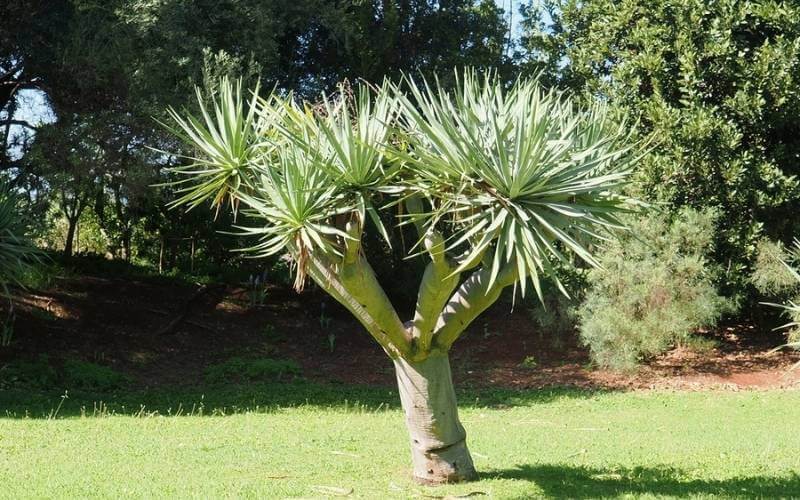
You don’t have to fuss over a dragon tree especially once it’s mature, but a little care will keep it healthy.
Watering
A newly planted dragon tree needs consistently moist (but not soggy) soil for about 2–4 weeks as it establishes roots.
Be careful not to overwater your dragon tree as it hates waterlogged soil. Water only around the base to prevent fungal diseases on leaves.
Once mature, the dragon tree is highly drought-tolerant, so rainfall is usually sufficient. You can do additional watering during long periods of drought or extreme heat.
In winter when the dragon tree is dormant, you can cut back on watering even further.
Fertilising
Feed your dragon tree with a slow-release, balanced fertiliser in spring — just once a year is enough.
Too much fertiliser can cause excessive leaf growth and prevent the tree from developing a sturdy trunk.
Pruning
Pruning is not usually necessary as the dragon tree barely grows each year. Just remove any brown or yellow leaves to keep your tree looking healthy.
If your dragon tree is growing too tall for your space, you can cut off the top branches to keep it to your desired size.
This will also encourage branching and give the dragon tree a bushier appearance.
Repotting
You’ll only need to repot your dragon tree every 2–3 years or when the roots start emerging through the drainage holes.
When repotting your dragon tree, trim any damaged roots and use a container just 5–8cm larger than its current one.
How to Propagate a Dragon Tree

You can propagate a dragon tree from branch cuttings. To start, choose a healthy branch at least 15cm long.
Use clean, sharp shears or a knife to cut off a 5–10cm section from the top of the branch. Be sure to include a few healthy leaves.
Wait for a few days to let the cut end dry and callous over. Then, dip the calloused end in rooting hormone powder to stimulate root growth.
Insert the cut end about 5cm deep into a small pot with well-draining soil or a succulent mix. Lightly water to settle the soil around your dragon tree cutting.
Cover the pot with a plastic bag that has a few small holes at the top. Place the pot in a bright location, but out of direct sunlight.
Keep the soil moist but not soggy, and allow it to dry slightly between waterings. Dragon trees take time to root, so be patient!
After 4–6 weeks, gently tug the cutting. If there’s resistance, roots have formed. At this point, you can remove the plastic bag and continue caring for your D. draco as usual.
Once your dragon tree has a strong root system — usually after 4–6 months or more — you can transfer it to a larger pot or plant it directly in the ground.
Common Dragon Tree Problems
Dragon trees are highly resilient, but they can encounter a few issues when not grown in the best conditions.
Fluoride toxicity
Dragon trees are sensitive to fluoride, which can cause brown, dead spots with a yellow halo on the leaves.
If these symptoms appear, check any potential fluoride sources, such as tap water or potting mixes high in perlite.
Switch to distilled water, or consider repotting the plant with a perlite-free or low-perlite potting mix.
Leaf spot
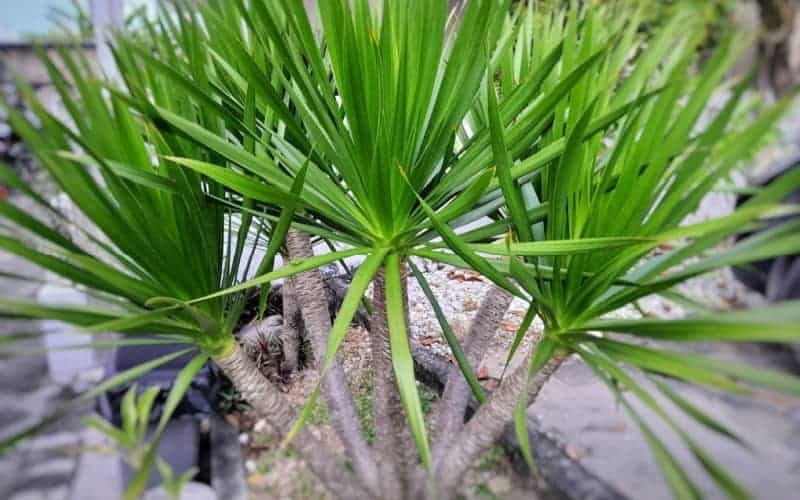
If you notice reddish or brownish spots with a yellow ring on the leaves of your dragon tree, it’s likely leaf spot.
To prevent this fungal infection, water only at the base of the trunk to avoid getting the leaves wet.
You can also spray the leaves with a baking soda solution (1 tbsp baking soda mixed in 1L of water) to help protect your dragon tree against fungus.
Root rot
Wilting, yellowing leaves on your dragon tree suggests root rot, a fungal disease caused by overwatering.
To check, gently dig around the base of the tree and inspect the roots — mushy, brown or black, and foul-smelling roots indicate an infection.
Immediately cut back on watering your dragon tree, and make sure your soil is draining well.
If the disease is severe or widespread, get professional help as it can be fatal.
Pests
Established dragon trees don’t get a lot of pests, but young ones can be prone to aphids, scale insects, and spider mites.
You can treat the pests with half a tablespoon of neem oil and a few drops of dish soap mixed in 1L of water.
Spray the dragon tree leaves — especially the undersides — once a week with your neem oil solution. Repeat until the bugs are gone.
FAQs: More About Growing a Dragon Tree

Discover more about the magnificent-looking dragon tree!
Is D. draco the only dragon tree?
No, D. draco is not the only dragon tree, although it’s often called the true dragon tree and the one most people think of when they hear the name.
Other types of dragon trees include the D. marginata and D. cinnabari.
Dracaena marginata, often called the Madagascar Dragon Tree, is a popular houseplant.
It has multiple slender trunks and long, thin leaves with red or pink edges (hence the name ‘marginata’).
Dracaena cinnabari, the Socotra Dragon Tree, has an umbrella-shaped canopy similar to D. draco, but more open and flattened at the top. It’s also larger than the D. draco.
These trees generally prefer similar growing conditions as the D. draco, though D. cinnabari is more sensitive to cold temperatures.
Is the dragon tree safe for pets?
No, dragon trees are not pet-friendly. All parts of the tree contain saponins, which are toxic to cats and dogs.
If your pet eats any part of a dragon tree, it might experience vomiting, diarrhea, or loss of appetite.
Call your vet right away if you suspect your pet nibbled on the plant!
Does a dragon tree produce dragon fruit?
Dragon trees (Dracaena draco) do not produce dragon fruit!
While D. draco grows small orange or red berries, these are not the edible dragon fruit you’re thinking of.
If you’re after the tropical fruit, look for the dragon fruit plant — a climbing cactus from the Hylocereus genus.
What can you plant with a dragon tree?
The kangaroo paw and snake plant make great companion plants for a dragon tree.
Snake plants, like D. draco, belong to the Dracaena genus and handle drought well.
Kangaroo paw, an Australian native, prefers sandy soil and thrives in dry conditions, just like the dragon tree.
When picking companion plants for your dragon tree, go for ones that can grow in the same setup: well-drained and slightly acidic soil, minimal watering, and a dry climate.

